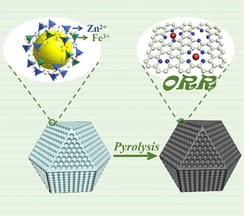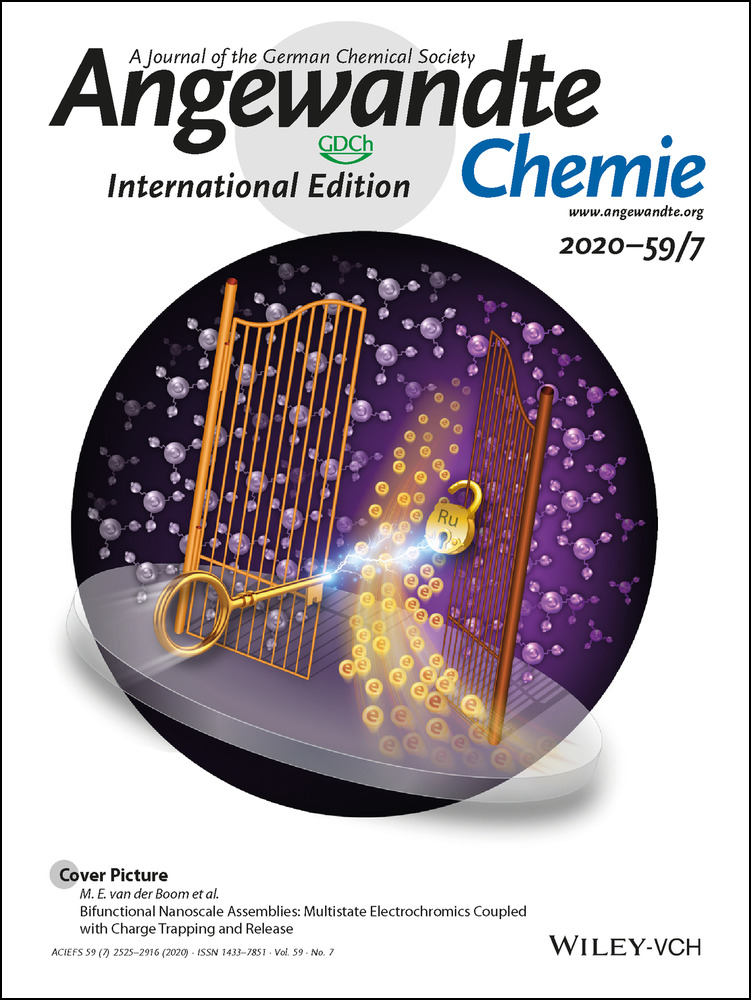Hierarchically Ordered Porous Carbon with Atomically Dispersed FeN4 for Ultraefficient Oxygen Reduction Reaction in Proton-Exchange Membrane Fuel Cells
Mengfei Qiao
Institute for Ecological Research and Pollution Control of Plateau Lakes, School of Ecology and Environmental Science, School of Chemical Science and Technology, Yunnan University, Kunming, 650504 China
Key Laboratory of Chemistry of Plant Resources in Arid Regions, State Key Laboratory Basis of Xinjiang Indigenous Medicinal Plants Resource Utilization, Xinjiang Technical Institute of Physics and Chemistry, Chinese Academy of Science, Urumqi, 830011 China
These authors contributed equally to this work.
Search for more papers by this authorYing Wang
Institute for Ecological Research and Pollution Control of Plateau Lakes, School of Ecology and Environmental Science, School of Chemical Science and Technology, Yunnan University, Kunming, 650504 China
Key Laboratory of Chemistry of Plant Resources in Arid Regions, State Key Laboratory Basis of Xinjiang Indigenous Medicinal Plants Resource Utilization, Xinjiang Technical Institute of Physics and Chemistry, Chinese Academy of Science, Urumqi, 830011 China
These authors contributed equally to this work.
Search for more papers by this authorQuan Wang
Institute for Ecological Research and Pollution Control of Plateau Lakes, School of Ecology and Environmental Science, School of Chemical Science and Technology, Yunnan University, Kunming, 650504 China
These authors contributed equally to this work.
Search for more papers by this authorCorresponding Author
Guangzhi Hu
Institute for Ecological Research and Pollution Control of Plateau Lakes, School of Ecology and Environmental Science, School of Chemical Science and Technology, Yunnan University, Kunming, 650504 China
College of Chemistry and Molecular Engineering, Zhengzhou University, Zhengzhou, 450000 China
Search for more papers by this authorCorresponding Author
Xamxikamar Mamat
Key Laboratory of Chemistry of Plant Resources in Arid Regions, State Key Laboratory Basis of Xinjiang Indigenous Medicinal Plants Resource Utilization, Xinjiang Technical Institute of Physics and Chemistry, Chinese Academy of Science, Urumqi, 830011 China
Search for more papers by this authorShusheng Zhang
College of Chemistry and Molecular Engineering, Zhengzhou University, Zhengzhou, 450000 China
Search for more papers by this authorCorresponding Author
Shuangyin Wang
State Key Laboratory of Chem/Bio-Sensing and Chemometrics,Provincial Hunan Key Laboratory for Graphene Materials and Devices, College of Chemistry and Chemical Engineering, Hunan University, Changsha, 410082 China
Search for more papers by this authorMengfei Qiao
Institute for Ecological Research and Pollution Control of Plateau Lakes, School of Ecology and Environmental Science, School of Chemical Science and Technology, Yunnan University, Kunming, 650504 China
Key Laboratory of Chemistry of Plant Resources in Arid Regions, State Key Laboratory Basis of Xinjiang Indigenous Medicinal Plants Resource Utilization, Xinjiang Technical Institute of Physics and Chemistry, Chinese Academy of Science, Urumqi, 830011 China
These authors contributed equally to this work.
Search for more papers by this authorYing Wang
Institute for Ecological Research and Pollution Control of Plateau Lakes, School of Ecology and Environmental Science, School of Chemical Science and Technology, Yunnan University, Kunming, 650504 China
Key Laboratory of Chemistry of Plant Resources in Arid Regions, State Key Laboratory Basis of Xinjiang Indigenous Medicinal Plants Resource Utilization, Xinjiang Technical Institute of Physics and Chemistry, Chinese Academy of Science, Urumqi, 830011 China
These authors contributed equally to this work.
Search for more papers by this authorQuan Wang
Institute for Ecological Research and Pollution Control of Plateau Lakes, School of Ecology and Environmental Science, School of Chemical Science and Technology, Yunnan University, Kunming, 650504 China
These authors contributed equally to this work.
Search for more papers by this authorCorresponding Author
Guangzhi Hu
Institute for Ecological Research and Pollution Control of Plateau Lakes, School of Ecology and Environmental Science, School of Chemical Science and Technology, Yunnan University, Kunming, 650504 China
College of Chemistry and Molecular Engineering, Zhengzhou University, Zhengzhou, 450000 China
Search for more papers by this authorCorresponding Author
Xamxikamar Mamat
Key Laboratory of Chemistry of Plant Resources in Arid Regions, State Key Laboratory Basis of Xinjiang Indigenous Medicinal Plants Resource Utilization, Xinjiang Technical Institute of Physics and Chemistry, Chinese Academy of Science, Urumqi, 830011 China
Search for more papers by this authorShusheng Zhang
College of Chemistry and Molecular Engineering, Zhengzhou University, Zhengzhou, 450000 China
Search for more papers by this authorCorresponding Author
Shuangyin Wang
State Key Laboratory of Chem/Bio-Sensing and Chemometrics,Provincial Hunan Key Laboratory for Graphene Materials and Devices, College of Chemistry and Chemical Engineering, Hunan University, Changsha, 410082 China
Search for more papers by this authorGraphical Abstract
Smart doping: When Fe-doped ZIF-8 single crystals were pyrolyzed, catalytically active FeN4 centers were atomically dispersed in a 3D hierarchical ordered porous carbon matrix. The interconnected carbon skeleton sufficiently meets the mass transfer requirement, thus boosting the catalytic efficiency for the oxygen reduction reaction (ORR).
Abstract
The low catalytic activity and poor mass transport capacity of platinum group metal free (PGM-free) catalysts seriously restrict the application of proton-exchange membrane fuel cells (PEMFCs). Catalysts derived from Fe-doped ZIF-8 could in theory be as active as Pt/C thanks to the high intrinsic activity of FeN4; however, the micropores fail to meet rapid mass transfer. Herein, an ordered hierarchical porous structure is introduced into Fe-doped ZIF-8 single crystals, which were subsequently carbonized to obtain an FeN4-doped hierarchical ordered porous carbon (FeN4/HOPC) skeleton. The optimal catalyst FeN4/HOPC-c-1000 shows excellent performance with a half-wave potential of 0.80 V in 0.5 m H2SO4 solution, only 20 mV lower than that of commercial Pt/C (0.82 V). In a real PEMFC, FeN4/HOPC-c-1000 exhibits significantly enhanced current density and power density relative to FeN4/C, which does not have an optimized pore structure, implying an efficient utilization of the active sites and enhanced mass transfer to promote the oxygen reduction reaction (ORR).
Supporting Information
As a service to our authors and readers, this journal provides supporting information supplied by the authors. Such materials are peer reviewed and may be re-organized for online delivery, but are not copy-edited or typeset. Technical support issues arising from supporting information (other than missing files) should be addressed to the authors.
| Filename | Description |
|---|---|
| anie201914123-sup-0001-misc_information.pdf2.5 MB | Supplementary |
Please note: The publisher is not responsible for the content or functionality of any supporting information supplied by the authors. Any queries (other than missing content) should be directed to the corresponding author for the article.
References
- 1
- 1aM. Shao, Q. Chang, J. P. Dodelet, R. Chenitz, Chem. Rev. 2016, 116, 3594–3657;
- 1bD. Yan, Y. Li, J. Huo, R. Chen, L. Dai, S. Wang, Adv. Mater. 2017, 29, 1606459.
- 2X. Huang, T. Shen, T. Zhang, H. Qiu, X. Gu, Z. Ali, Y. Hou, Adv. Energy Mater. 2019, 9, 1900375.
- 3Z. Zhang, J. Sun, F. Wang, L. Dai, Angew. Chem. Int. Ed. 2018, 57, 9038–9043; Angew. Chem. 2018, 130, 9176–9181.
- 4A. R. Zeradjanin, Curr. Opin. Electrochem. 2018, 9, 214–223.
- 5S. Yang, Y. Yu, M. Dou, Z. Zhang, L. Dai, F. Wang, Angew. Chem. Int. Ed. 2019, 58, 14724–14730; Angew. Chem. 2019, 131, 14866–14872.
- 6H. Zhang, S. Hwang, M. Wang, Z. Feng, S. Karakalos, L. Luo, Z. Qiao, X. Xie, C. Wang, D. Su, Y. Shao, G. Wu, J. Am. Chem. Soc. 2017, 139, 14143–14149.
- 7L. Shang, H. Yu, X. Huang, T. Bian, R. Shi, Y. Zhao, G. I. Waterhouse, L. Z. Wu, C. H. Tung, T. Zhang, Adv. Mater. 2016, 28, 1668–1674.
- 8L. Lv, S. Kang, X. Li, J. Shen, S. Liu, Nanotechnology 2018, 29, 485402.
- 9X. Wan, X. Liu, Y. Li, R. Yu, L. Zheng, W. Yan, H. Wang, M. Xu, J. Shui, Nat. Catal. 2019, 2, 259–268.
- 10
- 10aC. Zhu, Q. Shi, B. Z. Xu, S. Fu, G. Wan, C. Yang, S. Yao, J. Song, H. Zhou, D. Du, S. P. Beckman, D. Su, Y. Lin, Adv. Energy Mater. 2018, 8, 1801956;
- 10bJ. Niu, R. Shao, M. Liu, Y. Zan, M. Dou, J. Liu, Z. Zhang, Y. Huang, F. Wang, Adv. Funct. Mater. 2019, 29, 1905095.
- 11H. Hong, J. Liu, H. Huang, C. Atangana Etogo, X. Yang, B. Guan, L. Zhang, J. Am. Chem. Soc. 2019, 141, 14764–14771.
- 12Z. Zhang, M. Dou, H. Liu, L. Dai, F. Wang, Small 2016, 12, 4193–4199.
- 13S. Ratso, N. Ranjbar Sahraie, M. T. Sougrati, M. Käärik, M. Kook, R. Saar, P. Paiste, Q. Jia, J. Leis, S. Mukerjee, F. Jaouen, K. Tammeveski, J. Mater. Chem. A 2018, 6, 14663–14674.
- 14K. Shen, L. Zhang, X. Chen, L. Liu, D. Zhang, Y. Han, J. Chen, J. Long, R. Luque, Y. Li, B. Chen, Science 2018, 359, 206–210.
- 15L. Yang, X. Zeng, W. Wang, D. Cao, Adv. Funct. Mater. 2018, 28, 1704537.
- 16Z. Miao, X. Wang, M.-C. Tsai, Q. Jin, J. Liang, F. Ma, T. Wang, S. Zheng, B.-J. Hwang, Y. Huang, S. Guo, Q. Li, Adv. Energy Mater. 2018, 8, 1801226.
- 17J. Guo, M. Gao, J. Nie, F. Yin, G. Ma, J. Colloid Interface Sci. 2019, 544, 112–120.
- 18
- 18aH. Shen, E. Gracia-Espino, J. Ma, H. Tang, X. Mamat, T. Wagberg, G. Hu, S. Guo, Nano Energy 2017, 35, 9–16;
- 18bT. Li, J. Liu, Y. Song, F. Wang, ACS Catal. 2018, 8, 8450–8458.
- 19J. Li, M. Chen, D. A. Cullen, S. Hwang, M. Wang, B. Li, K. Liu, S. Karakalos, M. Lucero, H. Zhang, C. Lei, H. Xu, G. E. Sterbinsky, Z. Feng, D. Su, K. L. More, G. Wang, Z. Wang, G. Wu, Nat. Catal. 2018, 1, 935–945.
- 20
- 20aW. J. Lee, J. Lim, S. O. Kim, Small Methods 2017, 1, 1600014;
- 20bZ. Zhang, X. Gao, M. Dou, J. Ji, F. Wang, Small 2017, 13, 1604290.
- 21L. Wang, X. Jin, J. Fu, Q. Jiang, Y. Xie, J. Huang, L. Xu, J. Electroanal. Chem. 2018, 825, 65–72.
- 22T. Sun, S. Zhao, W. Chen, D. Zhai, J. Dong, Y. Wang, S. Zhang, A. Han, L. Gu, R. Yu, X. Wen, H. Ren, L. Xu, C. Chen, Q. Peng, D. Wang, Y. Li, Proc. Natl. Acad. Sci. USA 2018, 115, 12692–12697.
- 23H. Zhang, H. T. Chung, D. A. Cullen, S. Wagner, U. I. Kramm, K. L. More, P. Zelenay, G. Wu, Energy Environ. Sci. 2019, 12, 2548–2558.
- 24Q. Liu, X. Liu, L. Zheng, J. Shui, Angew. Chem. Int. Ed. 2018, 57, 1204–1208; Angew. Chem. 2018, 130, 1218–1222.





